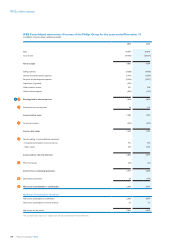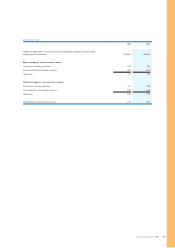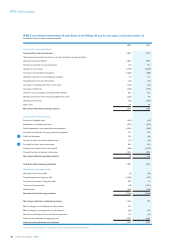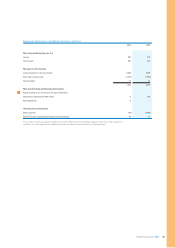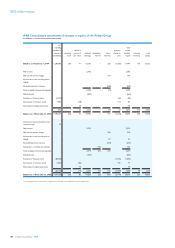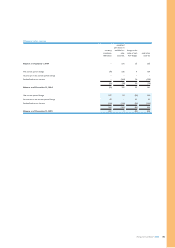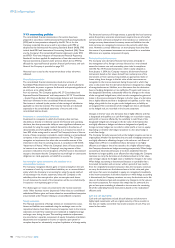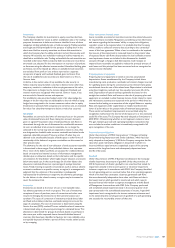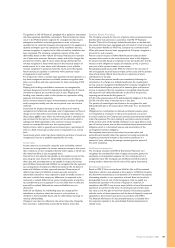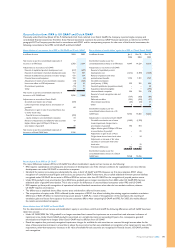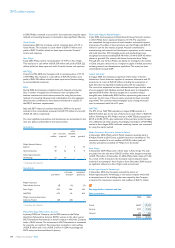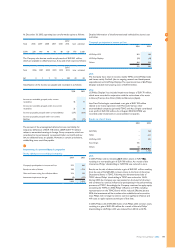Philips 2005 Annual Report Download - page 187
Download and view the complete annual report
Please find page 187 of the 2005 Philips annual report below. You can navigate through the pages in the report by either clicking on the pages listed below, or by using the keyword search tool below to find specific information within the annual report.
Philips Annual Report 2005 187
Investments
TheCompanyclassiesitsinvestmentsinequitysecuritiesthathave
readily determinable fair values as either available-for-sale or for trading
purposes.Investmentsindebtsecuritiesareclassiedinoneofthree
categories: trading, available-for-sale or held-to-maturity. Trading securities
are bought and held principally for the purpose of selling them in the
short term. Held-to-maturity securities are those debt securities in
which the Company has the ability and intent to hold the security until
maturity. All securities not included in trading or held-to-maturity are
classiedasavailable-for-sale.Tradingandavailable-for-salesecuritiesare
recorded at fair value. Held to-maturity debt securities are recorded at
amortized cost, adjusted for the amortization or accretion of premiums
or discounts using the effective interest method. Unrealized holding gains
and losses, net of the related tax effect, on available-for-sale securities
areexcludedfromprotorlossandarereportedasaseparate
component of equity until realized. Realized gains and losses from
thesaleofavailable-for-salesecuritiesaredeterminedonarst-in,
rst-outbasis.
A decline in the market value of any available-for-sale security or
held-to maturity security below cost that is deemed to be other than
temporary results in a reduction in the carrying amount to fair value.
The impairment is charged to the income statement. Dividend and
interest income are recognized when earned. Gains or losses, if any,
arerecordedinnancialincomeandexpenses.
For available-for-sale securities hedged under a fair value hedge, the
changes in the fair value that are attributable to the risk which is being
hedged are recognized in the income statement rather than in equity.
Investments in privately held companies are carried at cost, or estimated
fair value if an other-than-temporary decline in value has occurred.
Receivables
Receivables are carried at the lower of amortized cost or the present
valueofestimatedfuturecashows,takingintoaccountdiscounts
givenoragreed.Thepresentvalueofestimatedfuturecashowsis
determined through the use of allowances for uncollectible amounts.
As soon as individual trade accounts receivable can no longer be
collected in the normal way and are expected to result in a loss, they
are designated as doubtful trade accounts receivable and valued at the
expected collectible amounts. They are written off when they are
deemed to be uncollectible because of bankruptcy or other forms of
receivership of the debtors. Long-term receivables are discounted to
their present value.
The allowance for the risk of non-collection of trade accounts receivable
is determined in three stages. First, individual debtors that represent
3% or more of the debtor portfolio are assessed for creditworthiness
based on external and internal sources of information; management
decidesuponanallowancebasedonthatinformationandthespecic
circumstances for that debtor which might require valuation at amounts
below amortized cost. In the second stage, for all other debtors the
allowance is calculated based on a percentage of average historical
losses.Finally,if,owingtospeciccircumstancessuchasseriousadverse
economicconditionsinaspeciccountryorregion,itismanagement’s
judgment that the valuation of the receivables is inadequately
represented by the allowance in stage two, the allowance percentage
for the debtors in the related country or region may be increased to
cover the increased risk.
Inventories
Inventories are stated at the lower of cost or net realizable value,
less advance payments on work in progress. The cost of inventories
comprises all costs of purchase, costs of conversion and other costs
incurred in bringing the inventories to their present location and
condition. The costs of conversion of inventories include direct labor
andxedandvariableproductionoverheads,takingintoaccountthe
stage of completion. The cost of inventories is determined using the
rst-in,rst-out(FIFO)method.Thenetrealizablevalueofinventories
is determined using an allowance percentage for estimated losses. This
allowance is determined for groups of products based on purchases in
the recent past and/or expected future demand. Individual items of
inventorythathavebeenidentiedashavingazeronetrealizablevalue
are typically disposed of within a period of three months either by sale
or by scrapping.
Othernon-currentnancialassets
Loans receivable are stated at amortized cost, less the related allowance
for impaired loans receivable. Management, considering current information
and events regarding the borrowers’ ability to repay their obligations,
considers a loan to be impaired when it is probable that the Company
will be unable to collect all amounts due according to the contractual
terms of the loan agreement. When a loan is considered to be impaired,
the amount of the impairment is measured based on the present value
ofexpectedfuturecashowsdiscountedattheloan’seffectiveinterest
rate. Impairment losses are included in the allowance for doubtful
accounts through a charge to bad debt expense. Cash receipts on
impaired loans receivable are applied to reduce the principal amount of
such loans until the principal has been recovered and are recognized as
interest income thereafter.
Property, plant and equipment
Property, plant and equipment is stated at cost, less accumulated
depreciation. Assets manufactured by the Company include direct
manufacturing costs, production overheads and interest charges incurred
for qualifying assets during the construction period. Government grants
are deducted from the cost of the related asset. Depreciation is calculated
using the straight-line method over the expected economic life of the
asset. Depreciation of special tooling is generally also based on the
straight-line method. Gains and losses on the sale of property, plant and
equipment are included in other business income. Costs related to repair
and maintenance activities are expensed in the period in which they are
incurred unless leading to an extension of the original lifetime or capacity.
Plant and equipment under capital leases is initially recorded at the
lower of its fair value or the present value of minimum lease payments.
These assets and leasehold improvements are amortized using the
straight-line method over the shorter of the lease term or the estimated
useful life of the asset. The Company has early adopted as from January 1,
2004 IFRIC 4 ‘Determining whether an Arrangement contains a lease’.
The gain realized upon sale and operating leaseback transactions that
are concluded at market conditions is immediately recognized in full
upon recognition of the sale.
Asset retirement obligations
Under the provisions of IFRIC Interpretation 1 ‘Changes in Existing
Decommissioning, Restoration and Similar Liabilities’, which has been
early adopted as from January 1, 2004, the Company recognizes the fair
value of an asset retirement obligation in the period in which it is
incurred, while an equal amount is capitalized as part of the carrying
amount of the long-lived asset and subsequently depreciated over
the life of the asset.
Goodwill
Under the provisions of IFRS 3 ‘Business Combinations’ the Company
initially determines the amount of goodwill. Under the provisions of
IAS 36 ‘Impairment of Assets’, goodwill is not amortized but tested for
impairment annually in the second quarter or whenever impairment
indicatorsrequireso.InaccordancewithIFRS3theCompanyidentied
its cash generating units as one level below that of an operating segment,
whichisthelevelthatconstitutesabusiness,generatedcashows
thataresubstantiallyindependentfromothercashowsandthatis
the lowest level at which goodwill is monitored and which reports
discretenancialinformationtosegmentmanagementandtheBoard
of Management. In accordance with IFRS 3, the Company performed
and completed annual impairment tests in the second quarter of all
years presented in the consolidated statements of income. A goodwill
impairment loss is recognized in the income statement whenever and
to the extent that the carrying amount of goodwill of a cash-generating
unit exceeds the recoverable amount of that unit.



